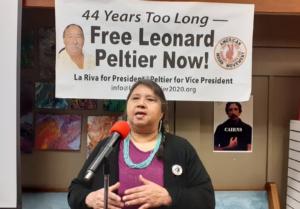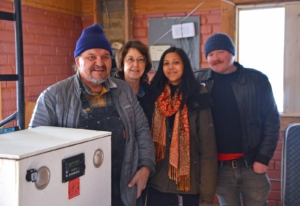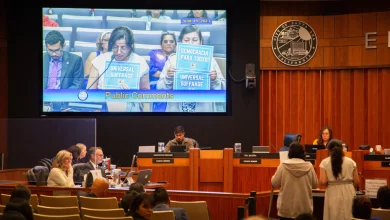Socialist candidate Gloria La Riva and our campaign team completed a visit in late January to the Black Hills region of South Dakota to meet with the communities of the Oglala Lakota Nation and for the struggle to free political prisoner Leonard Peltier.
We were hosted by Jean Roach, a dynamic community organizer in Rapid City. She is Mniconjou Lakota from the Cheyenne River Sioux Nation in South Dakota.
We were honored to be welcomed by the people of the community, to learn about their lives, their hopes as well as challenges that they face.
In our various community meetings, there was an overwhelmingly positive response in speaking of the national efforts for Leonard Peltier. Everyone knows who he is. For them, he is a hero who defended their struggle for Indigenous traditions, rights and sovereignty, and protection against a reign of terror on the Pine Ridge Reservation in the 1970a.
Leonard Peltier is paying a heavy price for his leadership, railroaded into prison and still behind bars after 44 years. There is no debate here, the people want his freedom now.
Film screening draws significant crowd

On a Friday night, our activities began in Rapid City, with the screening of the film “Incident at Oglala, The Leonard Peltier Story” to more than 60 people at the Cave Collective. Despite bone-chilling weather of 15 degrees and 50 mph winds, the turnout was a testament to the stature of Peltier in the community.
Joseph Birdshead, young Lakota and Cheyenne man from Oklahoma, began the evening with prayer and song, connecting the evening’s meeting with the traditional values that Peltier defends.
Before the film, Roach related her story as a 14-year-old witness and survivor of the fateful firefight that began on June 26, 1975, when two FBI agents raided the Jumping Bull Ranch on the reservation. The two FBI agents and one Native man, Joe Stuntz, were killed. Peltier’s co-defendants were found innocent by reason of self defense, but he had escaped to Canada so he was not tried at the same time. The FBI — enraged that Peltier’s co-defendants were exonerated — decided he would pay the price. They falsified evidence to illegally extradite Peltier from Canada and threatened witnesses in order to extract false testimony and assure a conviction.
Roach spoke of the government’s false case against Peltier. “The theory that the government had against Leonard was never proven,” she explained, “and his co-defendants were acquitted on the basis of self-defense… on the basis that we were attacked in the camp.”
She also explained how environmental activism is one way that the struggle continues. “Not only do we stand with the American Indian Movement, but we are Water Protectors… it’s pretty clear being a Native person, or a person who respects the Earth, the connection comes natural.”
La Riva spoke about the PSL’s 2020 election run as a fight-back campaign that highlights the need for socialism.
The fight for Paha Sapa, the Black Hills
On the continued violation of Native treaties and the expansion of corporate mining on Paha Sapa, known as the Black Hills, La Riva said, “We must always remember that this is stolen land, and it is still being stolen,” due to the expanded gold and uranium mining now underway, despite the facade of hearings for public comment.
The 1868 Ft. Laramie Treaty — between several Lakota bands; the Dakota, the Arapaho, and U.S. government — guaranteed that half of South Dakota would make up the Great Sioux Reservation, in addition to vast lands in North Dakota, Nebraska and Wyoming, deemed “unceded Indian territory.” The Reservation included the Black Hills or “Paha Sapa,” sacred to the Lakota.
But in 1874, gold was discovered in the Black Hills and the long-practiced pattern of U.S. treaty violations continued. U.S. army wars and white settler encroachments — enforced by massacres — further reduced the territory to the present-day reservations of South Dakota, in the most unproductive lands.
Although in 1980 the U.S. Supreme Court ruled that the Black Hills theft was in fact illegal, it only proposed a cash compensation. The Native nations have refused the cash settlement ever since, saying Paha Sapa is not for sale.
After the screening there was a lively discussion among attendees about the facts of the case. Participants closed by coming together and chanting “Free Leonard Peltier!”
Pine Ridge: Challenges and hope for Native nations

The next day, Jean Roach and Matilda Red Shirt took our team, La Riva and PSL organizers Candice Choo-Kang and Patrick McWilliams, to the Pine Ridge Reservation to meet with Indigenous activists.
Our first stop was to visit Henry Red Cloud, a Lakota leader who builds portable and large-scale systems to provide solar energy for the community. He taught himself the technology to develop a living alternative to the fossil fuel industry that is rapidly destroying the planet.
Red Cloud brought these solar systems to the Standing Rock camp during the struggle against the Dakota Access Pipe Line in the winter of 2016, where he and his wife Gloria Red Cloud Reyes provided the Water Protectors with battery-charging and light stations that had no need for the “black snake.”
Recognizing his remarkable work, Red Cloud received an honorary degree at George Washington University this year and a Champion of Change for Solar Deployment from President Obama in 2014.
While we witnessed these acts of solidarity and ingenuity embodied by people like Red Cloud, it was also impossible not to see the legacy of genocide committed by the U.S. government, the driving of Native people off their land to desolate areas, and deliberate starvation.
Pine Ridge has the highest infant mortality rate in the U.S., 300 percent the national average. With the extreme isolation, unemployment rate is close to 90 percent and 97 percent of the reservation’s population lives below the federal poverty line. The median family income is a shocking range of $2,600 to $3,500 per year. We saw much evidence of that, an almost complete lack of economy that could provide jobs. Rapid City is the nearest city, 120 miles away and transportation is not available. As in much of the U.S., the community has been hit hard by the methamphetamine epidemic, leading Pine Ridge’s president Julian Bear Runner to declare a state of emergency on the reservation.
These are the conditions — existing for decades — that led in 1968 to the formation of the American Indian Movement, to the struggle at Pine Ridge in 1973 by AIM and resident supporters who demanded an end to extreme poverty and repression. This is why Leonard Peltier and AIM leaders were targeted.
The Party for Socialism and Liberation and our La Riva/Peltier campaign aims to expand our solidarity with the Native community not only in South Dakota, but in other struggles as our members did at Standing Rock.
Encouraging in our visit to South Dakota was the growing activism among youth, to demand justice from the U.S. government and a strengthening of their sovereign economic and social demands.
Stolen children, stolen lives
We also attended a community meeting at the Oyate Community Center where people shared their experiences over the racist removal of their children by the South Dakota Department of Social Services. DSS perpetuates the racist and shameful practice of stealing Native children from their parents, their families and their culture, often never to be seen again.
We heard from many of the women and men, who courageously shared their experiences. They exposed the horrific physical, mental and sexual abuse suffered within the foster system.
One woman, Romina, told the attendees through tears, “I was raped at 9-years-old in my foster family’s home. I suffered beatings, every kind of abuse you can think of. I lived in the streets, under bridges, because I was afraid to go home to abuse.
“I never have told anyone what I went through, but I am speaking out today to help others.”
Others who were victims of the foster system told of the heartbreak and terror when their own children were also taken. They described a series of endless hoops that the State forces them to jump through to “prove” that they deserve to have their children back.
But no matter what they do, there is always one more hurdle in front of them, the main one being poverty. Once taken, the state demands that there be enough bedrooms to house each child. In households where living conditions are minimal and children share rooms, this is an impossible hurdle.
The state claims that they have to remove the children due to incidents of alcoholism or drug use. But as Jean Roach pointed out, the state workers are not trained for the proper disposition of these cases. More often than not, the children are placed in more dangerous situations.
Gloria La Riva stated, “Instead of kidnapping children from their family to unknown and often worse destinies, the federal and state government should be providing economic support and services to the families. They are themselves suffering from generations of extreme poverty and racism.
“Social services are drastically low funded. This kidnapping is an extension of the horrific removal of thousands of Native youth in the 20th century, from their families to the so-called ‘Indian schools’ where children were beaten, denied their language, their culture and their religion.
Natalie Stites Means, co-organizer of the meeting with Roach, and member of the Cheyenne River Sioux Nation, “The state is trying to say that being poor makes you a bad parent… Native children are 20 percent of the state population but 50 percent of the children in foster care are Native. This is causing homelessness, suicide, causing children to lose hope.
“If someone took my child, I don’t think I could endure one night of it, but these parents have suffered for years.”
By day’s end, the women came up with ideas for an action plan, including alternative care for the kids before DSS gets a hold of them. Later in the week, a rally was held outside the local DSS office, calling them out directly for their racism. It is an uphill battle but one that the community knows best how to overcome.
We were humbled and inspired by our experience in Oglala Lakota country, from Pine Ridge to the urban center of Rapid City. It deepened our resolve to strengthen our party’s work and presence in every community across the United States, in the struggle for socialism, liberation and true recognition of Native sovereignty.




